Buenos Aires – When Barrio Chino first sprang up over in Belgrano East, it was predominately Taiwanese. Over time, other Chinese, Japanese, and Koreans moved into the neighborhood, creating an international Asian community. However, the Taiwanese have continued to exert the strongest influence, and gradually the other groups moved to their own locales. In the south part of Barrio Flores, the Koreans have a concentrated community variously known as Coreatown, Pequeña Corea (sometimes, for unknown reasons, by their English names, Koreatown and Little Korea). It’s a somewhat lengthy bus ride out to the neighborhood, but we started out around noon, figuring we’d get there in time to look around and then have lunch.
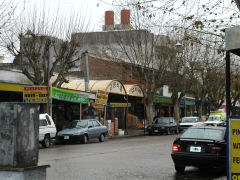 While Barrio Chino is clearly oriented around not only the Chinese community, but also “outsiders” and tourism (signs in Chinese, Spanish & English), Coreatown is not. The majority of signs are in Korean only, with no translations into anything else. The heart of the community is the intersection of the streets Castañares and Carabobo, the latter being the main commercial strip of the neighborhood. Carabobo, by the way, is difficult to translate as anything besides “the face of foolishness.” It’s also the name of a state in Venezuela. I don’t know if there’s some sort of history behind the naming of this street (or the state), it would be interesting to know! The other thing we immediately found is that the Korean community there is extremely suspicious of non-Koreans. The commercial portion of the neighborhood is little more than restaurants and markets, yet most doors were locked, and the shopkeepers just blantantly ignored our existence when it came to be buzzed in.
While Barrio Chino is clearly oriented around not only the Chinese community, but also “outsiders” and tourism (signs in Chinese, Spanish & English), Coreatown is not. The majority of signs are in Korean only, with no translations into anything else. The heart of the community is the intersection of the streets Castañares and Carabobo, the latter being the main commercial strip of the neighborhood. Carabobo, by the way, is difficult to translate as anything besides “the face of foolishness.” It’s also the name of a state in Venezuela. I don’t know if there’s some sort of history behind the naming of this street (or the state), it would be interesting to know! The other thing we immediately found is that the Korean community there is extremely suspicious of non-Koreans. The commercial portion of the neighborhood is little more than restaurants and markets, yet most doors were locked, and the shopkeepers just blantantly ignored our existence when it came to be buzzed in.
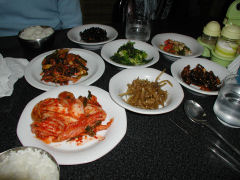 Immediately off of the bus stop at the core corner, is a small restaurant, the name only in Korean, at Carabobo 1688. It was open, though required being buzzed in (look for a blue and white sign hanging under the awning, should you decide to go). On entering, the proprietress demanded loudly to know what we wanted. When I said we were there for lunch (all eyes in the restaurant were on us at this point), she offered us a table, but then launched into a rapid-fire explanation of how we were unlikely to like Korean food, there was no menu in Spanish, and so she’d just have the kitchen make us some fried chicken. I explained that I like Korean food, have had it many times in other cities, and that it was Henry’s first time, so we’d like to have a more typical Korean lunch. You’d think she might brighten up at the thought, but no, she declined and flounced back to the kitchen.
Immediately off of the bus stop at the core corner, is a small restaurant, the name only in Korean, at Carabobo 1688. It was open, though required being buzzed in (look for a blue and white sign hanging under the awning, should you decide to go). On entering, the proprietress demanded loudly to know what we wanted. When I said we were there for lunch (all eyes in the restaurant were on us at this point), she offered us a table, but then launched into a rapid-fire explanation of how we were unlikely to like Korean food, there was no menu in Spanish, and so she’d just have the kitchen make us some fried chicken. I explained that I like Korean food, have had it many times in other cities, and that it was Henry’s first time, so we’d like to have a more typical Korean lunch. You’d think she might brighten up at the thought, but no, she declined and flounced back to the kitchen.
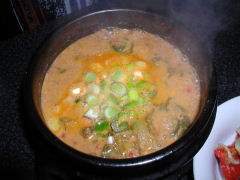 We were about to get up and leave when the cook wandered out into the dining room. I waved her over and explained again, throwing in words like “kim chee” and “bulgogi” and “bibimbop” to show off my vast knowledge. She was far more amenable and proceeded back to the kitchen. First out was an array of kim chee (as a note, I’ve been informed, kim chee does not mean pickled spicy cabbage, it’s a selection of preserved dishes of various types). This included the familiar spicy cabbage, equally spicy green onions, sesame doused watercress, sweet cured black algae, caramelized fish, sweet pickled burdock, and a light mushroom and pepper salad.
We were about to get up and leave when the cook wandered out into the dining room. I waved her over and explained again, throwing in words like “kim chee” and “bulgogi” and “bibimbop” to show off my vast knowledge. She was far more amenable and proceeded back to the kitchen. First out was an array of kim chee (as a note, I’ve been informed, kim chee does not mean pickled spicy cabbage, it’s a selection of preserved dishes of various types). This included the familiar spicy cabbage, equally spicy green onions, sesame doused watercress, sweet cured black algae, caramelized fish, sweet pickled burdock, and a light mushroom and pepper salad.
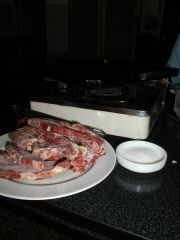 Following this we received two bubbling bowls of spinach soup. This was laced with green onions, small zucchini, and just a bit too much hot pepper and salt. Koreans do seem to like salt, I’ve noticed that in New York restaurants as well. Soup often is already salty, and is served with a large bowl of salt on the side to add more if you like. Despite that, the soup was really quite tasty and would be worth reproducing with a more balanced approach.
Following this we received two bubbling bowls of spinach soup. This was laced with green onions, small zucchini, and just a bit too much hot pepper and salt. Koreans do seem to like salt, I’ve noticed that in New York restaurants as well. Soup often is already salty, and is served with a large bowl of salt on the side to add more if you like. Despite that, the soup was really quite tasty and would be worth reproducing with a more balanced approach.
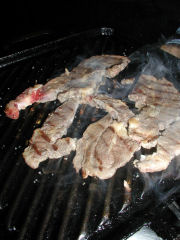 Our final course, bulgogi, or barbecued beef, required firing up the tabletop burner with a griddle on it. A plate of way too many small steaks (I think despite my request for 1 portion, we got 2), frozen rock-hard, and a bowl of salt, was dropped off at the table. A platter of lettuce leaves for wrapping the beef was brought a few minutes later. I tossed a few of the steaks on the grill and soon that wonderful aroma of seared beef filled the air. Cutting them into pieces with the shears that were provided, I wrapped them in lettuce leaves after a sprinkling of coarse salt. Yum!
Our final course, bulgogi, or barbecued beef, required firing up the tabletop burner with a griddle on it. A plate of way too many small steaks (I think despite my request for 1 portion, we got 2), frozen rock-hard, and a bowl of salt, was dropped off at the table. A platter of lettuce leaves for wrapping the beef was brought a few minutes later. I tossed a few of the steaks on the grill and soon that wonderful aroma of seared beef filled the air. Cutting them into pieces with the shears that were provided, I wrapped them in lettuce leaves after a sprinkling of coarse salt. Yum!
My only real negative to this place, other than the initial attitude (which was mitigated by the way as patron after patron, on leaving, stopped at the table to ask us if we were enjoying our Korean food), was the bill. By New York standards, 44 pesos or $15, isn’t much for such a lunch. By Buenos Aires standards, and especially for an out of the way neighborhood, it was outrageous. I asked if she was joking and she just stood there with her hand out. I don’t know if we were charged more than members of the community, but I wouldn’t be surprised. I blatantly picked up the remaining 2 frozen steaks from the platter, wrapped them in napkins, and stuck them in my jacket pocket, much to her obvious annoyance.
At the next-door vegetable market I bought a daikon to cook later, and transferred the steaks to the plastic bag… at least a couple of steak sandwiches out of this will take the sting out of the price.
[…] After my previous experience with Korean food and coreatown here, and no one having mentioned anything better, I had just sort of figured it was a lost cause. When my friend Victor asked if I wanted to go out for dinner at a Korean restaurant I accepted with some trepidation. However, he’s been in Buenos Aires for twelve years, so I figured he might know a thing or two about the restaurants here. Top that off with the restaurant he suggested was in easy walking distance of home and how could I say “no?” You pretty much have to know that Bi Won is there, at Junín 548, as there’s only a small wooden sign hanging high above the sidewalk. I guess that’s what makes the garden a secret. […]
[…] I must say that the area is much prettier in sunshine, but that’s true of many places. Like the last time I visited, the community remains fairly insular. Doors are locked, and being amongst the few white boys in the neighborhood, we were the object of suspicious glances and glares. This time I got the chance to wander a bit more. Interestingly, though the main commercial street of Carabobo is fairly run down, as soon as you step off of it into the residential area to the north you find well kept homes, many in quite modern styles. […]
> (as a note, I’ve been informed, kim chee does not mean pickled spicy cabbage, it’s a selection of preserved dishes of various types). This included the familiar spicy cabbage, equally spicy green onions, sesame doused watercress, sweet cured black algae, caramelized fish, sweet pickled burdock, and a light mushroom and pepper salad.
hi! actually, kimchee really is kimchee — pickled spicy cabbage. other pickled spicy veggies (like cucumbers, scallions, etc.) each have their own various names — but with kimchee attached to each particular name.
the various preserved dishes (or tapas) you are referring to, are called “ban-chan”. if the waitress brought out ban-chan when you asked for kimchee, she was probably accommodating you and being nice. 😀
There’s a whole thread on this topic here. I had always thought the same as you just stated, but quite a few people had written in to support the statement above, including Koreans, basically saying that “ban chan” and “kim chee” are used interchangeably within the community, and that “kim chee” referred more to the process of pickling things than the cabbage dish itself. I’m perfectly willing to keep them separate, but I get “corrected” in Korean restaurants on a regular basis. Personally, I think it’s just a Korean conspiracy to keep us 외국인 off balance.
[…] all the usual small dishes of ban chan – or whichever term one wishes to use, we’ve had this discussion before…. Not the best one I’ve ever had, and the spices were a bit muted, but it was […]
Hey Dan,
44 pesos, or $15, isn’t what you were paying for the usual Argentinian fare, right?
Did you consider that maybe it’s much more expensive, time and effort-wise, to serve authentic (ostensibly much more than a place like Bi Won) Korean food, particularly when it’s not really appealing to the general local palate?
Also, you mention that you got 2 portions of meat instead of 1; maybe this should have been corrected early (not sure if the lady who took the order didn’t speak English or Spanish well and misunderstood) and that would have taken the bill down a notch.
Don’t get me wrong, of course there are businesses that gyp people everwhere/in every ethnicity, etc. So that’s also a possibility.
Can’t hurt to minimize on the negative.
Actually, Colleen, no it was not a fair price at the time. Now, yes. But three years ago, 44 pesos for lunch for the two of us made it one of the most expensive places to eat in Argentina – lunch for two typically cost us 15-20 pesos, at good restaurants. We were able, at the time, to dine out at top restaurants for a 3-4 course dinner, with wine, for 50 pesos. And, the restaurant is located in the middle of a completely Korean community – likely we were among the only non-Koreans within blocks of there – so the food appealed just fine to the local palate. Most Argentines didn’t even know (and probably still don’t) that coreatown even existed. No, the woman who was running the place was blatantly atagonistic, rude, was trying to get rid of us because, I would be willing to bet, she didn’t want non-Koreans in her restaurant, and saw an opportunity to charge some “tourists” extra money. I’ve been back to the area many times since and eaten at other spots in the neighborhood, and no one else, even at the time, was charging anything close, nor treating us like that.
Hmm… I’m really sorry you had that experience. I myself, as a Korean American, have had a taste of that in Seoul when I visited. My boyfriend at the time, clearly non-Korean-apple-pie-American was studying air pollution at Seoul University and being seen with him caused some antagonism with people we interacted with sometimes.
Unfortunate, but rude people exist everywhere 🙁
Sorry again; glad to see that this didn’t deter you from continuing to explore Korean cuisine 🙂
Oh, nothing would deter me – I love Korean food, it was our standard late night fare after work in NYC as most of the Korean spots stayed open most of the night!
Just a caution….